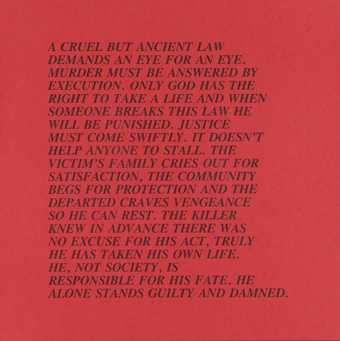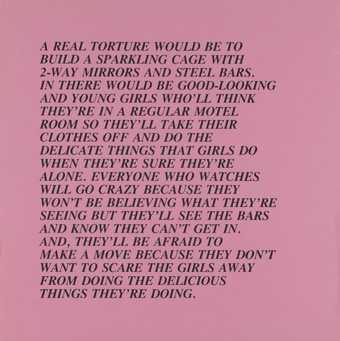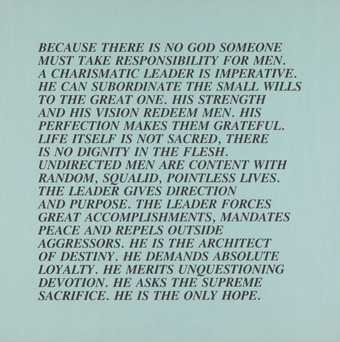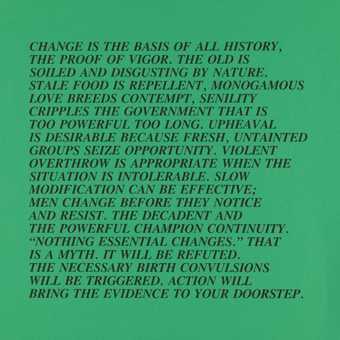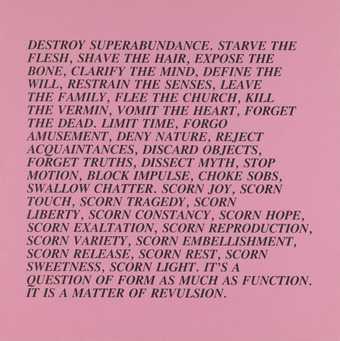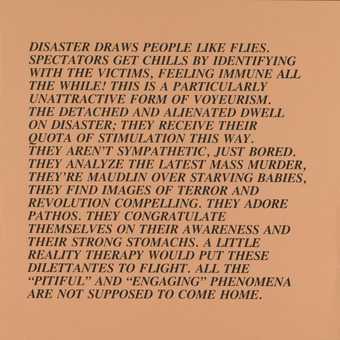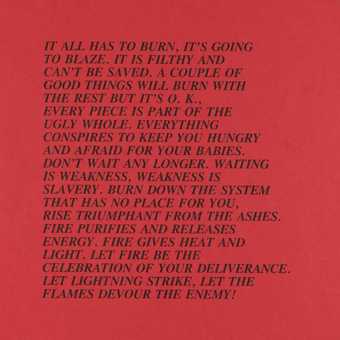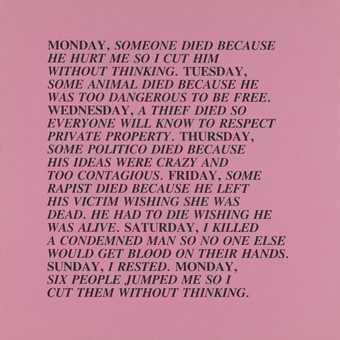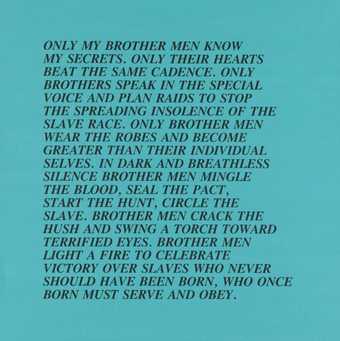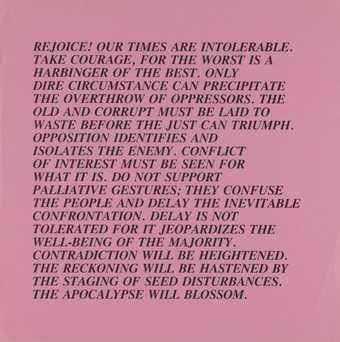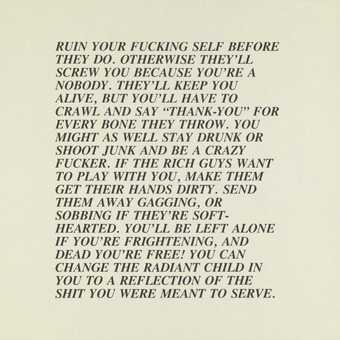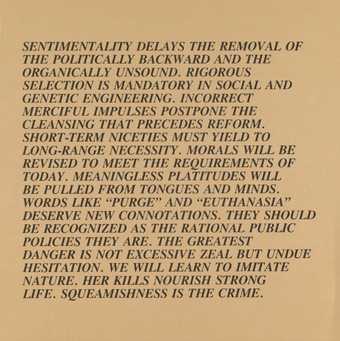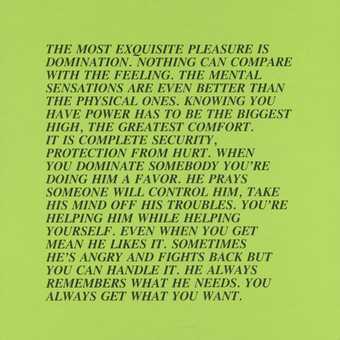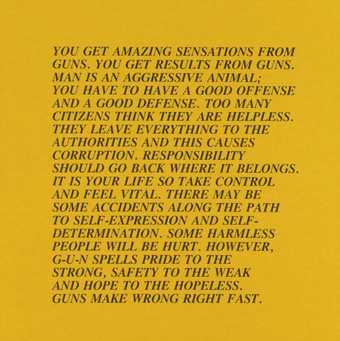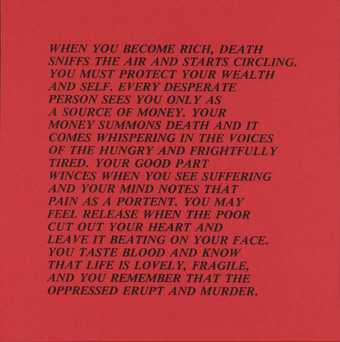In Tate Modern
Jenny Holzer
Free- Artist
- Jenny Holzer born 1950
- Part of
- Inflammatory Essays
- Medium
- Lithograph on paper
- Dimensions
- Image: 431 × 431 mm
- Collection
- Tate
- Acquisition
- Purchased 1983
- Reference
- P77382
Display caption
The Inflammatory Essays present a range of provocative statements which were inspired by the texts of political theorists, religious fanatics and impassioned 'folk' literature. Since childhood, Holzer has been interested in 'rapturous writing' and wanted to write 'ecstatic, fantastic things'.
Each essay has exactly 100 words in twenty lines, and Holzer uses this rigid format to explore a range of extreme ideas. She questions the viewer's response by setting fanatical statements against the certainties of common opinion. Originally the Essays were fly-posted across New York City.
Gallery label, October 2000
Does this text contain inaccurate information or language that you feel we should improve or change? We would like to hear from you.
Catalogue entry
P77382 [from] (i-xxix) Inflammatory Essays 1979–82 [P77382-P77412; complete]
29 offset lithographs 17 × 17 (432 × 432) on paper of various colours, printed at Millner Bros., New York and published by the artist in an unlimited edition
One inscribed ‘Jenny Holzer’ on the back
Purchased from Lisson Gallery (Grant-in-Aid) 1983
Lit: Carter Ratcliffe, ‘Jenny Holzer’, Print Collector's Newsletter, XIII, November–December, 1982, pp.149–52; Allan Schwartzman, ‘Bugs in the System’, Print Collector's Newsletter, XV, March–April, 1984, pp.10–11; Jeanne Siegel, ‘Jenny Holzer's Language Games’, Arts Magazine, LX, December, pp.64–8
The following entry, which has been approved by the artist, is based on answers provided by the artist in a letter of 30 May 1986 to questions posed by the compiler.
A number of the ‘Inflammatory Essays’ were first published in book form by the artist as Black Book Posters in 1979. These took the form of paragraphs printed on green paper. In the ‘Inflammatory Essays’ street posters, Holzer offset the texts on as many different colours as the printer could supply.
In the 1970s Holzer abandoned her practice as an abstract painter in order to make more explicit statements and to establish more direct contact with a larger audience than would visit galleries. Her art began to appear in the form of texts on posters which were exposed on the streets like fly-posters. In Jeanne Siegel's article and interview with the artist Holzer stated: ‘From the beginning, my work has been designed to be stumbled across in the course of a person's daily life. I think it has the most impact when someone is just walking along, not thinking about anything in particular, and then finds these unusual statements either on a poster or in a sign.’
The texts are provocative and their subjects range from the scientific to the political and interpersonal. According to Siegel almost any subject seemed suitable for exposition, with the exception of art which was deliberately avoided. Holzer explained to Siegel as follows:
What I tried to do, starting with the Truisms and then with the other series, was to hit on as many topics as possible. The truism format was good for this since you can concisely make observations on almost any topic. Increasingly I tried to pick hot topics. With the next series ‘Inflammatory Essays’, I wrote about things that were unmentionable or that were the burning question of the day.
In contrast to the ‘Inflammatory Essays’ which consist of paragraphs of text, ‘Truisms’ were statements confined to a length of one line which were either displayed together on a poster or broadcast as a continuous light display.
The tone of the ‘Inflammatory Essays’ is aggressive and challenging. The texts are the invention of the artist, although they do not necessarily reflect the artist's own views. From one Essay to another they ‘display a spectrum of views, from far-left to far-right. I wanted to talk about things that are very important to people but in a non-didactic way (the series as a whole with its conflicting views is not didactic). I tried to show how dangerous and absurd it is to be a fanatic, but how important it is to get things done’ (letter to the compiler). They often have the air of slogans found in graffiti form on walls in the city.
In preparation she read ‘Mao, Lenin, Emma Goldman, various religious and right wing fanatics, miscellaneous American anarchists and some “folk” crackpot literature’. Her intention was to ‘write things that were very hot - in tone and subject matter - to (hopefully) instill a sense of urgency in the reader. I wanted the reader to jump, at least, and maybe consider doing something useful.’ To this end the posters were first ‘wheat-pasted in the streets of Manhattan. They were placed wherever posters normally appear’ but the choice of text was not always arbitrary. ‘Sometimes I'd choose certain texts for certain neighbourhoods. It was fun to put particularly frightening ones uptown.’ Each week Holzer pasted up a different poster. In order to make clear that a new poster was on display she had them printed on paper of different colours and ‘to let the viewers know that the posters were part of a series, I made each poster exactly 100 words long and 20 lines’ (letter to the compiler).
When the posters are displayed in a gallery the artist likes ‘them to be pasted directly on the wall, from floor to ceiling with their edges overlapping slightly so that no wall shows through. It's good to completely cover a wall 10' × 25' in vertical or diagonal stripes of posters’ (letter to the compiler).
Published in:
The Tate Gallery 1982-84: Illustrated Catalogue of Acquisitions, London 1986
Explore
- abstraction(8,615)
-
- non-representational(6,161)
-
- text(1,043)
- universal concepts(6,387)
-
- irony(304)
- social comment(6,584)
-
- contemporary society(640)
You might like
-
Jenny Holzer [no title]
1979–82 -
Jenny Holzer [no title]
1979–82 -
Jenny Holzer [no title]
1979–82 -
Jenny Holzer [no title]
1979–82 -
Jenny Holzer [no title]
1979–82 -
Jenny Holzer [no title]
1979–82 -
Jenny Holzer [no title]
1979–82 -
Jenny Holzer [no title]
1979–82 -
Jenny Holzer [no title]
1979–82 -
Jenny Holzer [no title]
1979–82 -
Jenny Holzer [no title]
1979–82 -
Jenny Holzer [no title]
1979–82 -
Jenny Holzer [no title]
1979–82 -
Jenny Holzer [no title]
1979–82 -
Jenny Holzer [no title]
1979–82


